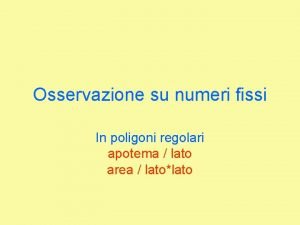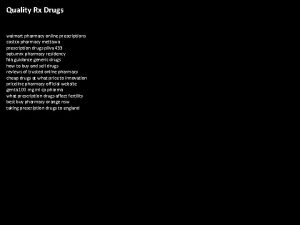Experimental Psychology PSY 433 Chapter 3 Experiments Designs






















- Slides: 22

Experimental Psychology PSY 433 Chapter 3 Experiments -- Designs

Two Kinds of Influence on DV n Systematic – affects the DV in the same way each time. Can introduce bias into results. n When it occurs due to the manipulation of the IV we call it an “effect. ” n n Random – varies and thus affects the DV differently from observation to observation. Can introduce “noise” into results. n Typically makes it more difficult to observe systematic influences. n

Confounding Variable n Any variable, besides the IV, that can influence the DV. n A potential cause for the experimental effect, other than the IV. n An alternative explanation for observed findings in a study. n Any variable whose values change systematically across levels of the IV.

Control Variable n A variable whose values remain the same across levels of the IV (e. g. , room temp, light levels, time-of-day, etc). n A goal in experimentation is to control as many variables as possible, to eliminate their potential effect on the DV. n Eliminates both confounds and noise. n Except for the IV, each subject should have as closely similar an experience in the experiment as possible.

Random Variable n Variable whose values vary randomly in an unbiased way across levels of the IV. n Random variables are usually created by the process of random assignment to levels in the experiment.

Subject Variable n A personal characteristic n Sex, height, weight, age, education, ethnicity, socio-economic status, etc. n Sometimes called a “demographic” variable. n Data describing subject characteristics should be collected in every study. n Can be controlled or left to vary unsystematically (through random assignment to levels).

Control Group n The group that receives no intervention, “zero” or “the absence of” the IV. n Eg, the placebo group in a drug experiment. n The group that serves as a baseline to compare with the behavior of the experimental groups.

Experimental Groups (Levels) n The groups that receive non-zero values of the IV, the groups receiving some intervention. The drug groups in a drug study. n Also called “levels” of the IV. n n The performances of these groups are compared with the performance of the control group.

Conceptual Definition n Definition of a variable at the conceptual or idea level. n Tends not to be very precise, more general. n May be expressed in terms of constructs (intervening variables).

Operational Definition n Specifies the operations or procedures necessary to measure the variables relevant to the conceptual definition. n Very precise. n Not general or vague at all. n Tells how the dependent variable was measured. n There may be many operational definitions (and DVs) for a single conceptual definition.

ODs and CDs - Example 1 n Conceptual - Amount of alcohol consumed n Operational - # of beers in 1 hour (0, 1, 2, 3) n Operational - grams of alcohol/kg body weight n Operational – blood alcohol content, BAC (mg alcohol/deciliter blood).

ODs and CDs - Example 2 n Conceptual - Helping behavior n Operational - # of people who help a “victim” in a defined context. n Operational - duration of helping behavior. n Operational - # seconds before helping occurs (latency).

Complex Designs n More than one IV n Left/Right and 1, 5, or 10 spaces from center n More efficient than single IV experiments n Gives more information n Allows analysis of main effects and interactions.

Complex Designs - Terminology n An IV is called a factor n number of numbers = how many IVs there are n values of numbers = how many levels each IV has n Examples: n “ 2 X 2 design” (two IVs, each with 2 levels) n “ 2 X 3 design” (first IV has 2 levels, second IV has 3 levels) n “ 2 X 8 design” (first IV has 2 levels, second IV has 8 levels) n “ 2 X 4 design” (first IV has 2 levels, second IV has 2 levels, third IV has 4 levels).

Main Effects n There is one potential main effect for each IV A 2 X 8 design has two possible main effects n A 2 X 4 has three possible main effects n n A main effect is present if an IV had a significant effect on the experiment’s outcome (regardless of the effects of the other IVs).

Interactions n Please memorize: “An interaction occurs if the effect of one IV varies depending on the level of the other IV”

Designing Experiments n Two general types of designs n Between-subjects (independent groups) = each group gets one level of the IV n Within-subjects (repeated measures) = each subject gets all levels of the IV n Equivalency of groups at each level is built- in for within-subjects and achieved by random assignment for between-subjects n Within designs require fewer subjects because there is less variability between levels.

Order Effects n Order effects (practice effects) = experiencing one level affects behavior in another level n Effects of practice, boredom, fatigue n Example: Does content (biology text vs. novel) affect proofreading speed? Order is Biology-Novel n Order effects are controlled in within-subjects designs by randomizing or counterbalancing the presentation orders.

Differential Carryover Effects n Carryover effects, differential/asymmetrical transfer effects occur when experiencing one level affects performance on the next. n The effect of the first level on the second level differs depending on which comes first. n Effect of B following A ≠ effect of A following B n Confound occurs when one level consistently precedes the other.

Order Effects in Proofreading Group 1 (no practice) Biology 1 (practice) Novel 2 (no practice) Novel 1 (practice) Biology 2 Group 2

Differential Carryover Effects in Problem Solving Group 1 Group 2 (no practice) Neutral instructions 1 (practice) Special instructions 2 (no practice) Special instructions 1 (practice) Neutral instructions 2

Other Considerations n Mixed designs (some between, some within) n Small-n designs n Matched groups designs n Demand characteristics = cues that tell subjects how they should behave (eg, drug studies) n Blind and double-blind procedures n Internal and external validity n Quasi experiments.
 Basic principles of experimental designs
Basic principles of experimental designs Matched pairs design vs block design
Matched pairs design vs block design Research design meaning
Research design meaning Basic principles of experimental design
Basic principles of experimental design Quasi-experimental research designs
Quasi-experimental research designs Quasi-experimental research designs
Quasi-experimental research designs Experimental vs non experimental
Experimental vs non experimental What are the 5 types of non experimental research design
What are the 5 types of non experimental research design Disadvantages of experimental research
Disadvantages of experimental research Experimental vs nonexperimental research
Experimental vs nonexperimental research Nonexperimental study
Nonexperimental study Abnormal psychology experiments
Abnormal psychology experiments Why is “replication key” psychology experiments?
Why is “replication key” psychology experiments? Figure poligoni
Figure poligoni Hdl-mhrcu.433
Hdl-mhrcu.433 Cpsc 433
Cpsc 433 Numeri fissi poligoni
Numeri fissi poligoni 720-433-0140
720-433-0140 Transfer prescription to costco
Transfer prescription to costco Liedboek 441
Liedboek 441 Chem 433
Chem 433 Me 433
Me 433 Sans mgt 433
Sans mgt 433











































